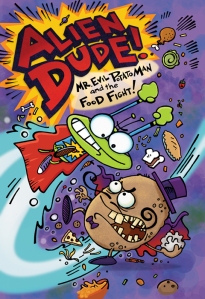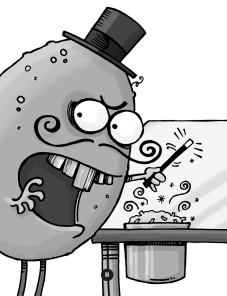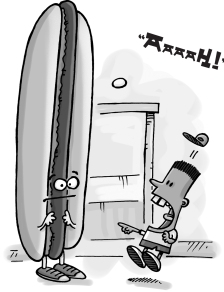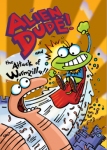Try! Try! Try! is an entertaining board book that encourages young readers to try new things.
Add a CommentViewing: Blog Posts Tagged with: Reluctant Readers, Most Recent at Top [Help]
Results 1 - 25 of 128
Blog: The Children's Book Review (Login to Add to MyJacketFlap)
JacketFlap tags: Animals, Reading Aloud, Reluctant Readers, featured, Board Books, Books for Boys, Animal Books, Dedicated Review, Ying Hui Tan, Lindsey Craig, Ages 0-3, Add a tag
Blog: ALSC Blog (Login to Add to MyJacketFlap)
JacketFlap tags: Audio books, reluctant readers, eBooks, Blogger Children and Technology Committee, eReaders/eBooks, Media Mentorship, downloadable audiobooks, Uncategorized, Literacy, Add a tag
Downloadable and streaming audiobooks have been on my mind again. Recently, some articles came out about the benefits of audiobooks for literacy; a revelation that probably surprised few of us in children’s and school library services. We did not create the Odyssey awards for nothing. ALA Editions published a wonderful book about it by Sharon Grover and Lizette D. Hannegan “back” in 2012. Last year, Rachel Wood from Arlington Public Library wrote an ALSC Blog post that stands as a primer for building an e-audio collection. But it always feels like a topic needs to come around a few times before the greater profession and the greater public latches on.

Perhaps it is not always content that is the way to hook a reluctant reader but format too. Dan Cohen from the DPLA wrote an article for The Atlantic talking about the powerful role that smartphones play in the lives of today’s teens and how this may be a way to bridge the digital divide. One of my own young relatives revealed to me that because she has difficulty reading, she uses audiobooks to keep up with her English class assignments. She finds and streams audiobook editions of assigned books on her smartphone. Recognizing that most parents and caregivers have smartphones, many libraries, like Spokane County Library District, are emphasizing their media mentor skills to recommend downloadable and streaming audiobooks and related apps for them to use with their children.
In the past, a former children’s librarian could feel alone in the greater e-content world. Too often children were not considered during e-content discussions. (Besides my fellow children’s librarians, who else at a meeting would excitedly prattle on about an audiobook of Winnie the Pooh in which Judy Dench gives voice to Kanga.) Now, we live in a world of Bookflix, Tumblebooks, and Overdrive Read-alongs. When children’s e-material did not circulate well during the early years of e-content platforms, I still believed it was worth building a collection. I knew at some point, this part of the market would grow. And, with the growth in downloadable audiobook circulation and sales, the time is upon us.
 Let’s admit. Unlike a book, a physical audiobook can be clumsy (yes I know, for some downloading from the library can be clumsy as well). I tried the entire carry ten discs onto the subway thing when I had longer commutes, and yes, I did miss a few stops because of a wonderful narrator. As well, technology has changed so rapidly as concerns personal electronics. A few months ago, a member of an audiobook award committee told me she had a hard time finding a store near her that still sold Discmans (she wanted one so she could listen for her committee while she went on her walks). In the age of tablets, smartphones, and smartwatches, I think more focus needs to be on downloadable and streaming e-content.
Let’s admit. Unlike a book, a physical audiobook can be clumsy (yes I know, for some downloading from the library can be clumsy as well). I tried the entire carry ten discs onto the subway thing when I had longer commutes, and yes, I did miss a few stops because of a wonderful narrator. As well, technology has changed so rapidly as concerns personal electronics. A few months ago, a member of an audiobook award committee told me she had a hard time finding a store near her that still sold Discmans (she wanted one so she could listen for her committee while she went on her walks). In the age of tablets, smartphones, and smartwatches, I think more focus needs to be on downloadable and streaming e-content.
To paraphrase Ranganathan: every young listener, their downloadable audiobook, and every downloadable audiobook, its young listener.
Michael Santangelo is the Electronic Resources Coordinator for BookOps, the shared technical services department for the New York Public Library and the Brooklyn Public Library, and the current chair of ALSC’s Children and Technology Committee.
The post Encouraging young listeners with downloadable and streaming audiobooks appeared first on ALSC Blog.
Blog: Jump Into A Book (Login to Add to MyJacketFlap)
JacketFlap tags: children's books, kidlit, book review, Reluctant readers, book extensions, family reading time, Something To Do, Gutsy Girl, Add a tag

March is Women’s History Month and we’re bringing the month to a close by celebrating in grand style. Before women make their history, they first had to have some focus, bravery, and perseverance to get them there. Let’s face it, all women have hurdles to jump over, but every woman that makes, and contributes, to history qualifies as a “Gusty Girl!”
Before we continue, we need to pause for a…..
WARNING !!!
” Many of the situations that the author encounters in this book have inherent dangers and can lead to serious or even fatal injuries. One particular undertaking-Climbing the Golden Gate Bridge-is also illegal and should not be attempted. Readers should not venture into any of these situations without professional instruction, suitable training, and proper supervision. Neither the publisher nor the author assumes ay responsibility for any injuries incurred by the reader.”
This is the first page of one of the greatest reads of the year. You’re probably in one of two camps after reading this warning. The first camp can’t wait to find out what could be in this book to create such a warning and the second camp will run as fast as they can. Just so you know, I’m in the first camp BUT I greatly advise people of the second camp to take a deep breath and read it anyway. There’s something for everyone to help unveil the gutsy in all of us.
First I had to know more about that Golden Gate Bridge story and second I just had to know more about author Caroline Paul, what type of woman is she and what escapades in her life led her to write a guidebook for tween girls about creating such adventures? The Gutsy Girl:Escapades for Your Life of Epic Adventure is probably one of the finest reads I’ve picked up so far in 2016.
Backstory
Author Caroline Paul was one of the first women on the San Franciso firefighting force as well as an experimental plane pilot, throughout the pages of her book we also learn that she is a recovering/rescue scuba diver. All this from a woman who says she was the biggest scaredy cat in the world as a child. Caroline greatly believes that girls are taught to be frightened by being instilled with the language of “fear”, while boys are fed that bravery and resilience are the goals to aspire to.
The Gutsy Girl: Escapades of Your Life of Epic Adventure is her antidote to empower tween girls to embrace their own bravery and resilience. This book is FUNNY and extremely imaginative and really intelligently written. Inside she shares her own stories one by one and the lessons and bravery she learned. Not all of them have happy endings but all of them have a take away to a new understanding of who she is or was at that time. This book is also part manifesto using language, insights, and encouragement into bravery and shear gutsiness. This is a guidebook however, and guidebooks mean you have to take action. Caroline Paul has also placed many great and inventive activities called Daring-Dos, as well as journal pages to reflect on ones own Daring-Dos experiences.
While sharing her escapades, author Caroline Paul is brilliant about showing the boundary lines between being gutsy and being stupid. She is always cautioning against being reckless and the difference between recklessness and being adventurous . She just doesn’t say it once, it’s sprinkled everywhere throughout the book in many different ways.
Some of My Favorite Parts
I learned some fun new things….
The illustrations in The Gusty Girl :Escapades for Your Life of Epic Adventure are done by her partner Wendy Macnaughton who also has a great sense of humor. One of my favorite illustrations is the Gutsy Girl International Phrase Book. It had me howling probably because I’ve needed to ask these very questions of people in far off lands and unknown languages.
Did you know this about how to know what temperature it is ?
So cool right ?
Something To Do
Writer Caroline Paul wasn’t always brave, or adventurous.
“I had been a shy and fearful kid. Many things had scared me. Bigger kids. Second grade. The elderly woman across the street. Being called on in class. The book Where the Wild Things Are. Woods at dusk. The way the bones in my hand crisscrossed.
Being scared was a terrible feeling, like sinking in quicksand. My stomach would drop, my feet would feel heavy, my head would prickle. Fear was an all-body experience. For a shy kid like me it was overwhelming.”
She gives great examples of current gutsy girls and women. Some known most we’ve never heard of but I’m so glad to know about them now.
Right within the pixels of Jump Into a Book we’ve had the pleasure of reviewing books based on Gutsy Girls. Here are a few of my favorites:
- Wilma Rudolf (The Quickest Kid in Clarksville)
- Malala Yousafzai (The Right to Learn)
- Helen Keller (Helen and Annie booklist)
Below you’ll find a list and some links to some more gutsy girls. Go discover them and see what their bravery and adventuresome spirit inspires you to do.
Please Meet
Laura Dekker who set sail on the boat she made and remodeled with her father. Just shy of her 15th birthday, she set sail around the world to become the youngest person to ever circumnavigate the globe ALONE.
Learn more about her here. She also has a blog and a book called One Girl, One Dream.

Marie Antoine started climbing trees as a kid for fun. Now she does it as her job. She’s one of the few botanists who work in the canopies of the world’s largest trees the redwoods. From 325 feet up in the air, you’ll find her munching her lunch and taking a little snooze in the hammock she brings along. That’s a long long way down. One of my personal daring dos is to climb up into a Redwood tree. Just thought I’d share that. I first learned of Marie from the book The Wild Trees by Richard Preston which talked about her and her husband Stephen Stillet and the work they do way up there. Here’s a great look at their lives.

Shark Whisperer Cristina Zenato grew up is the African Congo. She is an accomplished diver. Christina calms the sharks by rubbing around their nose and mouth along small jelly filled holes. This quiets the shark into a semi-paralytic state for up to 20 minutes. During the time the sharks are hypnotized, Christina pulls out fishhooks, removes parasites from their skins, and extracts various samples for scientific research. In lieu of being fearful of these large sea creatures, she calls them family and says they are greatly misunderstood. Do you know who else says that ? My eldest daughter, “Bun-Girl” who also has had her own adventures with sharks.
To find out more about Christina Zenato have a look here.
This book honestly speaks to girls and women of all ages. I found it to be timeless in it’s appeal. She beckons us to embrace the spirit of adventure or at the very least to explore the idea. She shares what it means to be brave, that perseverance is how to get through it, that we don’t need to be perfect just present and the most important take away for being a Gutsy Girl is to laugh at oneself a lot. That’s an important skill especially when trying to do nearly impossible things.

Are you a Gutsy Girl?
Ready to get your “sleuth” on? My Secret Codes, Mysteries and Adventures Activity PDF for kids will keep young minds percolating for HOURS!
Inside young super detectives will discover:
*19 pages of sleuthing fun for your family to enjoy.
*Use Pilot Frixion Pens and craft paper to create Invisible Secret Notes!
*Make I Spy Cookies!
*Discover a President of the United States who was a Master Code Creator!
This free activity guide is a great way to encourage kids to pull books off of shelves, discover the power of imagination and build a new excitement and anticipation for reading. Fill out the info below and grab your FREE copy. Enjoy!

My free gift to YOU!
The post If you’re a Gutsy Girl-Read This! appeared first on Jump Into A Book.
Add a CommentBlog: Kid Lit Reviews (Login to Add to MyJacketFlap)
JacketFlap tags: Children's Books, mysteries, Chocolate, Middle Grade, Series, detectives, Reluctant Readers, secrets, books for boys, ships, Julie Anne Grasso, Alexander Avellino, 4-Stars, Frankie Dupont and the High Seas Heist, luxury cruses, Add a tag
Frankie Dupont And The High Seas Heist SERIES: Frankie Dupont Mystery Series, Bk. #4 Written by Julie Anne Grasso Illustrated by Alexander Avellino Released 7/03/2015 978-0-9943216-0-2 132 pages Ages 8—12 “Frankie Dupont seems to catch odd-ball cases in the most unlikely places. You would think he would be used to it by now. …![]()
Blog: The Children's Book Review (Login to Add to MyJacketFlap)
JacketFlap tags: Books for Girls, Louise Fitzhugh, Humorous Books, Books into Movies, Yearling Books, Social Graces, Spy Books, Best Kids Stories, Reality Fiction, Ages 9-12, Classics, Humor, Chapter Books, Reluctant Readers, featured, Add a tag
Harriet the Spy, by Louise Fitzhugh, is an incredibly funny book—anyone who has ever felt like an outsider will certainly relate to Harriet.
Add a CommentBlog: Kid Lit Reviews (Login to Add to MyJacketFlap)
JacketFlap tags: Sky Pony Press, 5-Stars, Belly Laugh Jokes for Kids, Belly Laugh Knock-Knock Jokes for Kids, Bethany Straker, jokers, Sky Pony Press Editors, Children's Books, humor, laughter, Series, Reluctant Readers, books for boys, knock-knock jokes, Add a tag
Belly Laugh Jokes for Kids Belly Laugh Knock-Knock Jokes for Kids Written or Collected by Sky Pony Editors Illustrated by Bethany Straker Sky Pony Press 10/20/2015 978-1-63450-156-9 / 978-1-63220-437-0 138 (both) Ages 5+ Why is it a bad idea to tell an egg a joke? “Because it might crack-up!” Knock, Knock “Who’s …![]()
Blog: Kid Lit Reviews (Login to Add to MyJacketFlap)
JacketFlap tags: HarperCollins Publishers, 5stars, summer heat, Library Donated Books, Tom Watson, Stick Dog, Stick Dog Dreams of Ice Cream, feral dogs, friendship, Middle Grade, dogs, Favorites, Series, reluctant readers, Harper, Books for Boys, Add a tag
Look at all the falling snow. (Move your mouse right and left and watch the snow switch direction.) Virtual snow I can love. Real snow, not so much. What happened? As a kid I loved snow, played outside in the snow, was thrilled to see snow falling. Now, I groan. You might find yourself groaning …![]()
Blog: The Children's Book Review (Login to Add to MyJacketFlap)
JacketFlap tags: Herve Tullet, Best Kids Stories, Interview, Ages 0-3, Ages 4-8, Picture Books, Art, Interactive, Colors, Illustrator Interviews, Author Interviews, Reluctant Readers, featured, Best Sellers, Activity Books, Add a tag
What drove you to start creating children's books? A revolt! When I had my first child, children’s books looked like some stupid marketing thing.
Add a CommentBlog: The Children's Book Review (Login to Add to MyJacketFlap)
JacketFlap tags: Mo willems, Storytelling, Ages 0-3, Ages 4-8, Picture Books, Book Lists, Interactive, Chronicle Books, Reading Aloud, Reluctant Readers, featured, Herve Tullet, Best Kids Stories, B.J. Novak, Storytelling Tips, Add a tag
"...individual readers can make the experience more child-centered by engaging kids in a dialogue."
Add a CommentBlog: The Children's Book Review (Login to Add to MyJacketFlap)
JacketFlap tags: Ages 4-8, Ages 9-12, Book Lists, Art, Drawing, Interactive, Reluctant Readers, Activity Books, Christopher Hart, Teens: Young Adults, Beautiful Art Activity Books, Laurence King Publishing, Learn How to Draw Books, Linda Scott, M.J. Bronstein, Watson-Guptill Publications, Add a tag
Manga for the Beginner Kawaii, My Monster Bubblewriter Book and Photoplay! all seek to engage readers by providing prompts and tips to spark creativity.
Add a CommentBlog: The Children's Book Review (Login to Add to MyJacketFlap)
JacketFlap tags: Board Books, Ann James, Janeen Brian, Animal Books, Bath Time, Rhyming Text, Poetry & Rhyme, Ages 0-3, Reluctant Readers, Dinosaurs, featured, Add a tag
This musical, rhythmic dinosaur book is a delight for small children getting ready for bath time.
Add a CommentBlog: Here in the Bonny Glen (Login to Add to MyJacketFlap)
JacketFlap tags: Comics, Homeschooling, reluctant readers, Read-Alouds, teaching reading, Early Childhood Education, natural learning, reading lessons, Add a tag
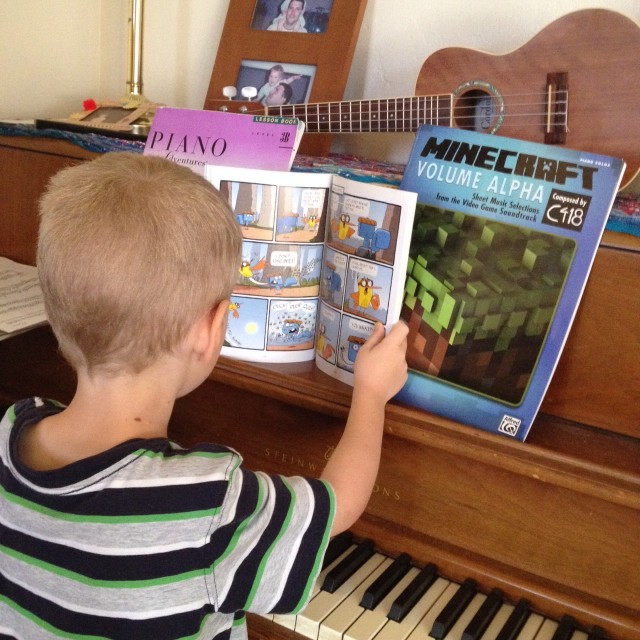
Reading a Bird and Squirrel book by James Burks
I chimed in on a discussion on my local homeschooling list about one mom’s concerns that her son had stalled on the learning-to-read process. As usual I found I had a lot to say, so I’m scooping it here (and expanding a bit) in case it’s of interest to others.
I’ll second what E. said: Six is really very young and at this point (and every point, really), the VERY BEST thing you can do is to read aloud a great deal. There are lots of studies to back up what many of us have been discovering and advocating for years about the immense and rather extraordinary benefits of reading aloud.
Some tricks we have used
• We always turn on the captions when our children watch TV. And it’s amazing how much reading they can pick up from scrolling through the DVR. Huck could distinguish between “Little Bear” and “Little Bill” at age three—his first sight words.
• Video games! or apps, etc. My kids have all picked up a lot of reading just from encountering the repeated text instructions and captioning that is a part of many games.
• Comics and graphic novels. Great reinforcement of decoding skills and incentive to read. My 3rd child learned to read from Tintin Comics. Her older sisters read them and she pored over the pictures until she began to pick up words. (I read them to her whenever she asked but that stage didn’t last long–she just loved to explore them them on her own!) (I’ve written more about this here.)
• Word games and puns. We are a wordy, wordy family. Dinner-table conversation will often involve why a thing is called what it’s called–what the root word is, where it came from. Someone will hop up to look up a word origin. And scarcely a day passes without some terrible, groan-inducing pun trotting around the house. When I teach kids’ writing and lit classes (I’m teaching three different groups of kids at present), I begin every class by soliciting contributions to our ‘Word Hoard’—asking the kids to look out for interesting words during the week to add to our collection. They really get into the spirit of the game and we have amassed some splendid word piles over the weeks. The boys in my Friday afternoon class have turned it into a competition of sorts, unfurling mile-long words to impress their classmates. I’ve learned a lot of obscure medical terms in the past month, let me tell you.
• Riddles, jokes, joke books!
I am not a fan of 100 Easy Lessons because of so many similar stories of kids getting turned off to reading, or stressed/intimidated/bored–
Books of facts are great for young kids–early reader science stuff, etc. Again, lots of pictures to draw them in & help with decoding.
My primary advice is to not try to “teach” a child to read.
The process can be more organic, less structured. Help them along the way you helped and encouraged them to learn to talk. Read together, allowing lots of conversation and lingering and interruptions to hyperfocus on some little piece of a picture.* Looking for street signs (kids will pick those up as sight words very quickly and naturally). Or names of stores, etc. Text is all over our world, not just in books, and reading doesn’t have to be a Capital R academic exercise. People naturally want to find things out, and reading becomes a means of doing that–so sooner or later, every child will have an interest that drives literacy. What you can do is support that interest. Feed it! Rustle up some intriguing-looking books on the topic, preferably ones with a lot of art.
(Here I come back to video games: one of my girls got so interested in a certain game that she wanted to look up guides for it online, and HER reading took a huge leap forward as she began to devour information about this game. My role was to help her safely find resources on the internet, print out useful pages, provide supplies for assembling a binder (her idea)…so you can see there are many ways for a parent to be involved in the process, guiding, facilitating, without it looking like formal reading instruction–an activity that is so stressful for many children. Lots of so-called ‘reluctant readers’ will inhale anything you give them that’s about their favorite video game. Let them hunt for cheat sites. Who cares if they don’t figure out a game level on their own? They are learning crucial research skills–how to frame questions and find answers, and how to apply that information to a practical task. Hurrah for game cheats!)
Current example: Huck is obsessed with Rose’s Snap Circuits set. This morning I stood in the living room for the longest time, watching him—his back was to me—deeply absorbed in assembling one of the projects in the guidebook. He has worked his way through the entire project book with minimal help, following the picture instructions but also puzzling out chunks of text. Sometimes he asks for help with a mouthful word like “capacitor”—no self-consciousness, no sense that he is young to be expecting to be able to read a word like that. He can’t figure it out, he asks for help. But poring over this book, casually encountering these giant words that tell him things he wants to know, has catapulted his reading skills forward in a way no teacher, no matter how good, how patient, could reproduce. If I made him sit down to a reading curriculum, I can guarantee he would be restless and fretful within minutes. But he’ll spend the whole afternoon immersed in building projects out of this book, interacting with the pictures and text, following complex directions—and consider it ‘playing.’ As in, “Can I play with your Snap Circuits again today?” he’ll ask his big sister.
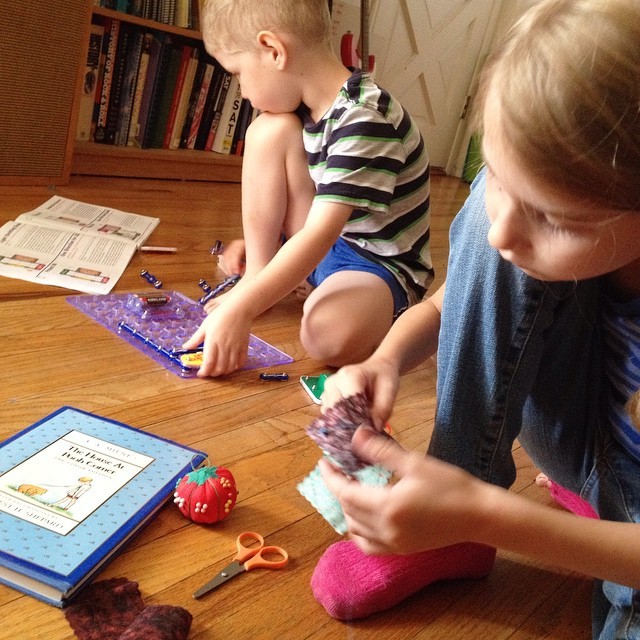
*********
*Let me elaborate on what I said above about “allowing lots of conversation and lingering and interruptions to hyperfocus on some little piece of a picture.” This is a mistake I’ve seen many adults make. A lot of adults have difficulty tolerating interruptions during a readaloud. There’s a whole big conversation to be had about how much background activity to allow — like, Legos keep little hands busy but can be very noisy. There are ways to work around that (spread out Legos on the floor before reading, since the noisiest part is the digging through the bin–things like that). But what I want to focus on right now are the interruptions that come when a child is looking at the book with you and starts talking over the narrative–pointing at things in the art, or otherwise being chatty about the book instead of listening to the story. This activity may actually be an indication of a big leap forward in skill acquisition–but we adults don’t always see it that way!
Here’s an example — when Rose was five or six, I remember reading her My Father’s Dragon. She was right at the point of emergent literacy, beginning to recognize words like street signs and store names as I mentioned above. We were about halfway through this short novel as a readaloud when she started pointing out Elmer’s name on every page. And “the dragon” and “the cat” — words repeated often in the story. But mainly it was the word “Elmer” (the main character). It got to where I couldn’t get through a page, because she kept pointing at the name all over the place. And I had a moment of being irritated and wanting to hush her–now now, let’s listen to the story. But it hit me in a flash that what we were doing together — what SHE was experiencing in this moment — had changed. It had started out “listening to a story.” Now it was READING. She had learned a sight word and was putting this new skill to use, with numerous opportunities to “practice” it on every page. No curriculum in the world could top this skill practice, because it was completely voluntary and completely absorbing her. It was HER activity, not one imposed upon her from the outside.
So, in that hour snuggled beside her on her bed, I let go of the whole listen-to-this-story concept. I kept on reading to her, page after page, but that was merely a background activity providing the vehicle for her discovery. “Elmer…Elmer…the dragon…” — little finger pointing, skipping around the page. We finished the book that way, with Rose only half paying attention to the words I was reading. When I got to the end, she said it was the best book ever and asked me to start it over. The second time through, she listened raptly to the narrative.  Her brain had finished its self-assigned task. By the time I finished the book for the second time (a week or two later), she was reading very well on her own.
Her brain had finished its self-assigned task. By the time I finished the book for the second time (a week or two later), she was reading very well on her own.
So that’s what I mean about stepping back to reassess an activity and your objectives….if a child is hyperfocusing on some part of the story that isn’t your voice reading the words, there is probably a very good reason. A wonderful thing about homeschooling is we have the luxury of time and space to allow this process to unfold at the child’s pace–there is no pressure to ‘get through’ a certain amount of material by a set date.
Add a CommentBlog: The Children's Book Review (Login to Add to MyJacketFlap)
JacketFlap tags: Ryder Windham, Fantasy: Supernatural Fiction, Daniel Lipkowitz, Best Kids Stories, LEGO Building, Holman Wang, Jack Wang, LEGO Books, May the 4th Be with You Books, Ages 0-3, Ages 4-8, Ages 9-12, Book Lists, Chronicle Books, Reluctant Readers, featured, Books for Boys, DK Publishing, Star Wars Books, Jeffrey Brown, Add a tag
The Children's Book Review strikes back with the return of the Star Wars book list. Grab your favorite little droid and treat them to a galactic read—the force is strong in these books.
Add a CommentBlog: Kid Lit Reviews (Login to Add to MyJacketFlap)
JacketFlap tags: book for boys, Dragnet, 5stars, Library Donated Books, Creston Books, Debut Illustrator, Robin Newman, beginning to read on your own, The Case of the Missing Carrot Cake, Chapter Book, mystery, Favorites, Reluctant Readers, Books for Boys, whimsical, witty, Deborah Zemke, Add a tag
Quick note: Not surprisingly, the motherboard died one last time, just days after arriving home from its last death. I am at the library and running out of time. Please excuse the unfinished post. I will get all images and links up as son as I can. I hope you enjoy the review, such as it is. ~Sue
X
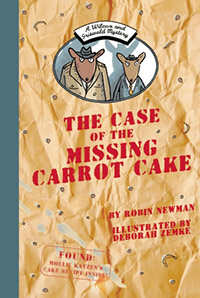 x
x
x
The Case of the Missing Carrot Cake
Written by Robin Newman
Illustrated by Deborah Zemke
Creston Books 2015
978-1-939547-17-0
40 pages Age 7—9
X
X
“When food goes missing on Ed’s farm, Detectives Wilcox and Griswold do what it takes to track down the thieves. In this case, Miss Rabbit’s carrot cake has disappeared. Has it been stolen? Or eaten? Or both? Who dunnit?” [publisher]
Review
Oh, my, a carrot cake has gone missing and Miss Rabbit, besides being crumbed by cake from head to toe (she did bake the now missing carrot cake), is hopping mad. Good thing the MFI’s are on the case, with Captain Griswold and Detective Wilcox as lead investigators. These two small Missing Food Investigator mice may have experience, but the layered Case of the Missing Carrot Cake just might be unsolvable.
I know detectives do not want to be viewed as cute, but cute is an apt word. From their gruff-looking MFI badge pictures, to their droll 1950’s cop-speech—think Friday of Dragnet—Griswold and Wilcox are all business, but adorable. The two made me laugh each time they spoke. Kids may not know who Sargent Friday was, but if a parent were to channel Sargent Friday while reading Detective Wilcox’s story, their children will at least get part of the joke.
“It was 10:00 Monday morning. The captain and I were working the day shift when we got our first call . . . Every day food goes missing from the farm. Sometimes it’s lost. Sometimes it’s stolen. Sometimes it just runs away.”
The first four chapters introduce the usual suspects: Fowler, the Owl (Alibi. He was picking up his dinner in the field); Porcini, the Pig (a convicted corn robber, he was with Miss Rabbit—she refused a refreshing hot cup of slop); Hot Dog, a dog (evidence is found! Hot Dog is, according to Wilcox, “in as pickle”); and . . . uh, oh. Where did suspect number four hide? I know there is a fourth, but, unlike Detective Wilcox, I am no missing food investigator.
The Case of the Missing Carrot Cake will delight readers. Kids will love the goofy characters, the illustrations, and the oft-used humor. Adults will also laugh, and sometimes groan, but always appreciate the humor and Wilcox’s Dragnet performance.
“Just give us the facts and nothing but the facts . . . “
The illustrations enhance the story on every page. The short chapters, just right for readers learning to read on their own, and illustrations that make each page come alive, kids will begin viewing reading as entertainment, rather than something one only does in school. Each of the seven characters is well-developed with distinctive personalities. I love Hot Dog, who towers over the detectives, yet gives them all due respect. Twists do occur, so do not get cozy with your solution to this case.
Will the MFI solve The Case of the Missing Carrot Cake? Will the residents of Ed’s Farm ever be safe from bakery thieves? To find out, check out Newman’s debut chapter book. I hope there are more cases to solve. The MFI detectives can delight readers again and again . . . they just need missing food to find.
THE CASE OF THE MISSING CARROT CAKE. Text copyright © 2015 by Robin Newman. Illustrations copyright © 2015 by Deborah Zemke. Reproduced by permission of the publisher, Creston Books,
Purchase The Case of the Missing Carrot Cake at Amazon—Book Depository—iTunes—Creston Books.
Learn more about The Case of the Missing Carrot Cake HERE.
Meet the author, Robin Newman, at her website:
Meet the illustrator, Deborah Zemke, at her website:
Find more chapter books at publisher, Creston Books, website: http://www.crestonbooks.com
Review Section: word count = 473
Copyright © 2015 by Sue Morris/Kid Lit Reviews. All Rights Reserved
x
x
ftc
Filed under: 5stars, Books for Boys, Chapter Book, Debut Illustrator, Favorites, Library Donated Books, Reluctant Readers Tagged: beginning to read on your own, book for boys, Creston Books, Deborah Zemke, Dragnet, mystery, Robin Newman, The Case of the Missing Carrot Cake, whimsical, witty
Blog: Kid Lit Reviews (Login to Add to MyJacketFlap)
JacketFlap tags: Children's Books, school, Series, Reluctant Readers, aliens, Books for Boys, Early Reader, 4stars, Library Donated Books, Alien Dude!, Alien Dude! #2: Mr. Evil Potato Man and the Food Fight!, E. K. Smith, Peter Grosshauser, Zip Line Publishing, Add a tag
x
Alien Dude! #2: Mr. Evil Potato Man and the Food Fight!
Written by E. K. Smith
Illustrated by Peter Grosshauser
Zip Line Publishing 9/27/2014
978-0-9883792-1-3
64 pages Age 7—9
x
x
“When the villain Mr. Evil Potato Man puts a spell on the school food, students start turning into food and a huge food fight erupts. Alien Dude morphs into a peeler and peels, then fries the giant potato. Once the fries are eaten, the spell is broken.” [publisher summary]
x
Review
Alien Dude is an early reader for reluctant readers. Aimed at boys (and girls who enjoy alien superheroes), Alien Dude is an enjoyable story about a little alien-student. As Alien Dude sits, quietly working on his lessons, the lunch bell rings. He flies off to the cafeteria, but a quiet lunch will not last long. As kids eat, they start turning into items of food. Pizza, hot dogs, ice cream, and a hamburger with all the works begin popping up at lunch tables. Veggies, too. What in the name of popcorn is going on?
Alien Dude realizes the EVIL Mr. Evil Potato Man has caused the chaos. Alien Dude jumps onto his table and yells,
“Don’t eat the school food! He put a spell on the food.”
Then Mr. Evil Potato Man—the villain—yells . . .
Can you guess what he yells?
He yells,
“Food Fight!!”
The grey-scale illustrations show kids morphing into food. I would have preferred color interior illustrations. Grosshauser’s ability shines on the covers; a marvelous sight sure to catch passing eyes. The cover also masks the simplicity of the story inside. Young boys—and girls—will not be ashamed to read Alien Dude. a story geared toward reading ability, not the reader’s age. The three chapters are composed of one or two sentences per page, with large illustrated characters. Smith repeats words and simple sentence structures to build reluctant readers’ ability and love of reading.
Alien Dude has special powers, as all superheroes should possess. He can fly, fr course, but the little alien can also morph into any working object of his choice. To defeat Mr. Evil Potato Man, Alien Dude morphs into a potato peeler, following up with a slicer, and finally a fryer. Still, the spell . . . Alien Dude disposed of the villain, but the kids, they’re still cafeteria food.
Young children will enjoy the cafeteria humor and the unusual ending. However, I wonder why Alien Dude flies off rather than finish his school day. Maybe this Alien Dude’s reward for cooking the villain’s goose, so to speak. Alien Dude is a series. Book 1: Alien Dude! and the Attack of Wormzilla!! is also available. I enjoyed Alien Dude and think young children will also like the school age alien. He could be sitting next to them right now.
ALIEN DUDE!: MR. EVIL POTATO MAN AND THE FOOD FIGHT! Text copyright © 2014 by E. K. Smith. Illustrations copyright © 2014 by Peter Grosshauser. Reproduced by permission of the publisher, Zip Line Publishing, Charlotte, NC.
x
Purchase Alien Dude! at Amazon—B&N—Book Depository—Zip Line Publishing.
x
Learn more about Alien Dude! HERE.
Meet the author, E. K. Smith, at her linkedin: http://linkd.in/1CvjTyw
Meet the illustrator, Peter Grosshauser, at his short bio: http://bit.ly/1FdmW5y
Find more reluctant readers at the Zip Line Publishing website: http://zipintoreading.com/
x

Copyright © 2015 by Sue Morris/Kid Lit Reviews
Filed under: 4stars, Books for Boys, Children's Books, Early Reader, Library Donated Books, Reluctant Readers, Series Tagged: Alien Dude!, Alien Dude! #2: Mr. Evil Potato Man and the Food Fight!, aliens, E. K. Smith, Peter Grosshauser, school, Zip Line Publishing
Blog: Kid Lit Reviews (Login to Add to MyJacketFlap)
JacketFlap tags: Children's Books, Reading, Picture Book, NonFiction, writing, Favorites, Chronicle Books, Reluctant Readers, Kate Messner, Mark Siegel, Library Donated Books, 6 Stars TOP BOOK, Top 10 of 2015, How to Read a Story, Add a tag
x
How to Read a Story

Written by Kate Messner
Illustrated by Mark Siegel
Chronicle Books 5/5/2015
978-1-4521-1233-6
32 pages Age 4 to 8
“STEP 1: Find a Story.
“STEP 2: Find a Reading Buddy.
“STEP 3: Find a Cozy Reading Spot.
“Kate Messner and Mark Siegel brilliantly chronicle the process of becoming a reader, from choosing a book and finding someone with whom to share it to guessing what will happen and—finally—coming to The End. How to Read a Story playfully and movingly illustrates the idea that the reader who discovers the love of reading finds, at the end, the beginning.” [book jacket]
Review
Early readers will love this short primer on how to read a picture book. A young boy sits among dozens of books trying to find the perfect one. If you look closely, you will see the dog is laying on what will become the final choice: The Princess, the Dragon, and the Robot. I love little details that ask the reader to pay close attention.
Step 4 says to look at the cover and try to decipher what the story will be about. Step 5 is the most exciting step as you finally crack the cover, turn to page 1, and begin reading.
“Once upon a time . . .”
I love this book. From the cover on, How to Read a Story is a perfect primer on reading a picture book—the start of a love of reading. One important point: talking like the characters, whether a powerful mouse or a hungry knight, using character voices will increase a reader and listener’s enjoyment of the story. The author uses different fonts to emphasize these changing voices.
The ink and watercolor illustrations are cute and really add to the instructions as they draw you into How to Read a Story. Young kids—and parents—will love the young boy and his reading partner curling up in a soft over-stuffed chair reading and listening, until step 8, when they take a break to predict what might happen next in The Princess, the Dragon, and the Robot. Stiegel illustrates each possibility in a talk-bubble.
“Will the princess tame the dragon?
“Will the robot marry the princess?
“Will the dragon eat them all for lunch?”
During Step 2, everyone—except the dog—had better things to do than read to the young boy; by the end of his reading aloud, they are all interested in the end. Each of the ten important steps helps teach the wonderment of reading to young children. How to Read a Story looks fantastic and its text is important for all to learn. Once you have read a picture book—following the steps—there is one-step left:
“When the book is over say, ‘The End.’
“And then . . . start all over again.”
HOW TO READ A STORY. Text copyright © 2015 by Kate Messner. Illustrations copyright © 2015 by Mark Siegel. Reproduced by permission of the publisher, Chronicle Books, San Francisco, CA.
x
Purchase at How to Read a Story Amazon—B&N—Book Depository—Chronicle Books.
x
Learn more about How to Read a Story HERE.
Meet the author, Kate Messner, at her website: http://www.katemessner.com/
Meet the illustrator, Mark Siegel, at his website: https://www.tumblr.com/tagged/mark-siegel
Find more picture books at the Chronicle Books website: http://www.chroniclebooks.com/
x

Copyright © 2015 by Sue Morris/Kid Lit Reviews
Filed under: 6 Stars TOP BOOK, Children's Books, Favorites, Library Donated Books, NonFiction, Picture Book, Reluctant Readers, Top 10 of 2015 Tagged: Chronicle Books, How to Read a Story, Kate Messner, Mark Siegel, Reading, writing
Blog: Kid Lit Reviews (Login to Add to MyJacketFlap)
JacketFlap tags: Children's Books, Reading, Picture Book, NonFiction, writing, Favorites, Chronicle Books, Reluctant Readers, Kate Messner, Mark Siegel, Library Donated Books, 6 Stars TOP BOOK, Top 10 of 2015, How to Read a Story, Add a tag
x
How to Read a Story

Written by Kate Messner
Illustrated by Mark Siegel
Chronicle Books 5/5/2015
978-1-4521-1233-6
32 pages Age 4 to 8
“STEP 1: Find a Story.
“STEP 2: Find a Reading Buddy.
“STEP 3: Find a Cozy Reading Spot.
“Kate Messner and Mark Siegel brilliantly chronicle the process of becoming a reader, from choosing a book and finding someone with whom to share it to guessing what will happen and—finally—coming to The End. How to Read a Story playfully and movingly illustrates the idea that the reader who discovers the love of reading finds, at the end, the beginning.” [book jacket]
Review
Early readers will love this short primer on how to read a picture book. A young boy sits among dozens of books trying to find the perfect one. If you look closely, you will see the dog is laying on what will become the final choice: The Princess, the Dragon, and the Robot. I love little details that ask the reader to pay close attention.
Step 4 says to look at the cover and try to decipher what the story will be about. Step 5 is the most exciting step as you finally crack the cover, turn to page 1, and begin reading.
“Once upon a time . . .”
I love this book. From the cover on, How to Read a Story is a perfect primer on reading a picture book—the start of a love of reading. One important point: talking like the characters, whether a powerful mouse or a hungry knight, using character voices will increase a reader and listener’s enjoyment of the story. The author uses different fonts to emphasize these changing voices.
The ink and watercolor illustrations are cute and really add to the instructions as they draw you into How to Read a Story. Young kids—and parents—will love the young boy and his reading partner curling up in a soft over-stuffed chair reading and listening, until step 8, when they take a break to predict what might happen next in The Princess, the Dragon, and the Robot. Stiegel illustrates each possibility in a talk-bubble.
“Will the princess tame the dragon?
“Will the robot marry the princess?
“Will the dragon eat them all for lunch?”
During Step 2, everyone—except the dog—had better things to do than read to the young boy; by the end of his reading aloud, they are all interested in the end. Each of the ten important steps helps teach the wonderment of reading to young children. How to Read a Story looks fantastic and its text is important for all to learn. Once you have read a picture book—following the steps—there is one-step left:
“When the book is over say, ‘The End.’
“And then . . . start all over again.”
HOW TO READ A STORY. Text copyright © 2015 by Kate Messner. Illustrations copyright © 2015 by Mark Siegel. Reproduced by permission of the publisher, Chronicle Books, San Francisco, CA.
x
Purchase at How to Read a Story Amazon—B&N—Book Depository—Chronicle Books.
x
Learn more about How to Read a Story HERE.
Meet the author, Kate Messner, at her website: http://www.katemessner.com/
Meet the illustrator, Mark Siegel, at his website: https://www.tumblr.com/tagged/mark-siegel
Find more picture books at the Chronicle Books website: http://www.chroniclebooks.com/
x

Copyright © 2015 by Sue Morris/Kid Lit Reviews
Filed under: 6 Stars TOP BOOK, Children's Books, Favorites, Library Donated Books, NonFiction, Picture Book, Reluctant Readers, Top 10 of 2015 Tagged: Chronicle Books, How to Read a Story, Kate Messner, Mark Siegel, Reading, writing
Blog: The Children's Book Review (Login to Add to MyJacketFlap)
JacketFlap tags: Reluctant Readers, ABC's, Dinosaurs, featured, Books for Boys, Alphabet Books, Picture Books For Children, Janee Trasler, Sterling Children's Books, Cavemen Books, Ages 0-3, Ages 4-8, Alphabet, Picture Books, Humor, Add a tag
Blog: First Book (Login to Add to MyJacketFlap)
JacketFlap tags: young adult books, young adult literature, poetry, poet, Books & Reading, Authors & Illustrators, newbery award, Reluctant readers, author interview, Basketball, sports books, Kwame Alexander, Add a tag
We recently had the opportunity to talk with author Kwame Alexander about how poetry can draw a reluctant reader into a lifelong love of books and the creative process behind his book, “The Crossover,” awarded the 2015 Newbery Medal for Most Distinguished Contribution to American Literature for Children.

Author Kwame Alexander
Photo Credit: Pilar Vergara
The first thing we noticed about The Crossover: its rhythm. Why did you choose to have Josh’s voice rhythmic in that way?
When I decided the book was going to have a frame of basketball, I knew that I wanted the language to mirror the sport’s high energy and rhythm,
I thought that basketball was poetry in motion – so I created a story on the page that reflected the action on the court. I’ve been a poet most of my life, so it seemed like a good marriage.
How would you describe kids’ reaction to the book?
You want to impact young people. That’s the goal. That’s the only goal. You want to get them reading. The response initially came from librarians and teachers – they were loving it.
I thought, “Wow, how cool is that?”?
Then teachers started getting it to their students. My, my, my – the reaction from the students blew me away. There were quite a few boys who had never showed much interest in reading before. Their teachers and librarians contacted me and said, “They couldn’t put your book down.”
That’s pretty remarkable right there. That’s why I’m doing this.
Have you ever seen anyone perform a page from the book?
Yes! There was a school in Illinois – Granger Middle School – and the entire school read the book. They brought me in for the day to see some presentations, and the kids all 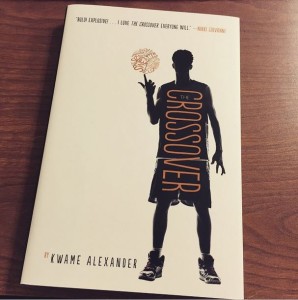 memorized the poems. It was so awesome. Each kid – girl, boy, black, white – they all felt like they were the characters.
memorized the poems. It was so awesome. Each kid – girl, boy, black, white – they all felt like they were the characters.
That’s all you really hope for from a book – that it’s going to resonate with young people and empower them in some way. I believe poetry can get kids reading.
Why is it so important to get kids reading?
Inside of a book, between the lines, is a world of possibility. The book opens it up.
Why is it important for kids to open books? Because they can see themselves and they can see what they can become… Open a book and find your possible.
Click here to browse First Book’s collection of ALA Award-winning books.
The post Kwame Alexander Q&A: Poetry Provides Possibilities appeared first on First Book Blog.
Blog: The Children's Book Review (Login to Add to MyJacketFlap)
JacketFlap tags: Books for Girls, Reader's Digest, Little Simon, American Presidents, Brain Quest, National Geographic Children's Books, TIME for Kids, Quirk Books, Kenneth C. Davis, Smithsonian Institute, Teens: Young Adults, Ken Jennings, Amy Bausum, David Stabler, Doogie Horner, Fandex, Guides about Presidents, Noah McCullough, Pedro Martin, President's Day Books, Presidential Trivia, Random House Publishing Group, Workman Publishing Company, HarperCollins, General, Ages 4-8, Ages 9-12, Book Lists, Political Science, American History, Interactive, Current Affairs, Reluctant Readers, Gift Books, Presidents, Books for Boys, Add a tag
These books, guides, and cards offer interesting trivia and facts, engaging formats, and lively illustrations; a perfect combination to pique interest for hours of casual reading, followed by days of reciting trivia, and hopefully, years of knowledge about these important people in American history.
Add a CommentBlog: (Login to Add to MyJacketFlap)
JacketFlap tags: reluctant readers, learning to read, struggling readers, reading games, Keep Reading Fun Day, Add a tag

Happy Monday, or, as I like to call it, "Keep Reading Fun Day"! Today I want to talk about the power of reading games.
So often learning to read can feel like very serious business, and this "serious business" can lead to loads of stress for both parent and child. Of course, feeling stressed does not help good learning... or good teaching. In fact, it pretty much makes both impossible. :(
So, how can we get past this sometimes miserable situation?
Take away the stress, of course. Stop making it so serious. :)
But when you are a stressed out parent whose child is not liking reading, this can feel hard to do.
That is where reading games can come in. My son needed to work on recognizing more sight words. He also needed to become more strategic about his decoding by using word chunks instead of going letter by letter.
I could easily see that those were his two weaknesses. But, who wants to focus on their weaknesses?
I wanted to make this fun! For him and for me. So I went looking for some games to address these two needs.
And, yay! I found a great popcorn sight words game (pictured above) and Chunks: The Incredible Word Building Game. (Homemade games are awesome too! I was just too stressed to make some right then. :) )
Hard work didn't feel so hard when it was done in the context of a game. Quickly, he started to get these skills that had felt so frustrating. Soon (very soon), we didn't need the games anymore.
He was just reading. Everything in sight. :)
Could it have happened without the games? Maybe. But the games sure took a lot of stress off of both of us, and made reading a whole lot of fun.
Have you used reading games with your kids? What games did you try? How did they go?
Blog: The Children's Book Review (Login to Add to MyJacketFlap)
JacketFlap tags: Fun Facts & Silly Stories, Ripley's, Ages 4-8, Ages 9-12, Picture Books, Science, Humor, Author Interviews, Reluctant Readers, Gift Books, featured, Author Showcase, Add a tag
In this interview, we discuss Fun Facts & Silly Stories 3, the third title in the Ripley’s Believe It or Not® successful Fun Facts and Silly Stories series.
Add a CommentBlog: The Children's Book Review (Login to Add to MyJacketFlap)
JacketFlap tags: Fun Facts & Silly Stories, Ripley's, Ages 4-8, Ages 9-12, Picture Books, Science, Humor, Reluctant Readers, Gift Books, Author Showcase, Add a tag
The third title in the Ripley’s Believe It or Not® successful Fun Facts and Silly Stories series is here: Ripley’s Fun Facts and Silly Stories 3.
Add a CommentBlog: The Children's Book Review (Login to Add to MyJacketFlap)
JacketFlap tags: Picture Books, Science, Humor, Reluctant Readers, Gift Books, featured, Author Showcase, Fun Facts & Silly Stories, Ripley's, Ages 4-8, Ages 9-12, Author Interviews, Animal Books, Add a tag
As the world authority on all that is unbelievable, we're supper excited to chat with Ripley Publishing, an arm of Ripley Entertainment Inc. and the owner of the internationally famous trademark Ripley’s Believe It or Not!
Add a CommentBlog: The Children's Book Review (Login to Add to MyJacketFlap)
JacketFlap tags: Ages 4-8, Ages 9-12, Picture Books, Science, Humor, Reluctant Readers, Gift Books, Animal Books, Fun Facts & Silly Stories, Ripley's, Add a tag
Fun Facts & Silly Stories: The Big One! is the newest addition to Ripley’s successful Fun Facts and Silly Stories series. Each of the pages in this massive new collection of bizarre truths is loaded with information primed to capture the attention of every child out there.
Add a CommentView Next 25 Posts








